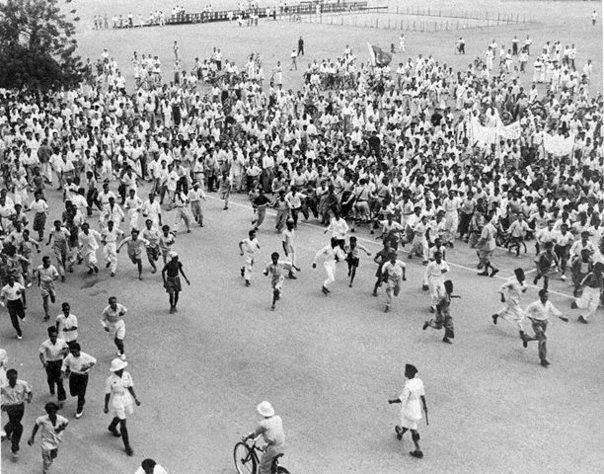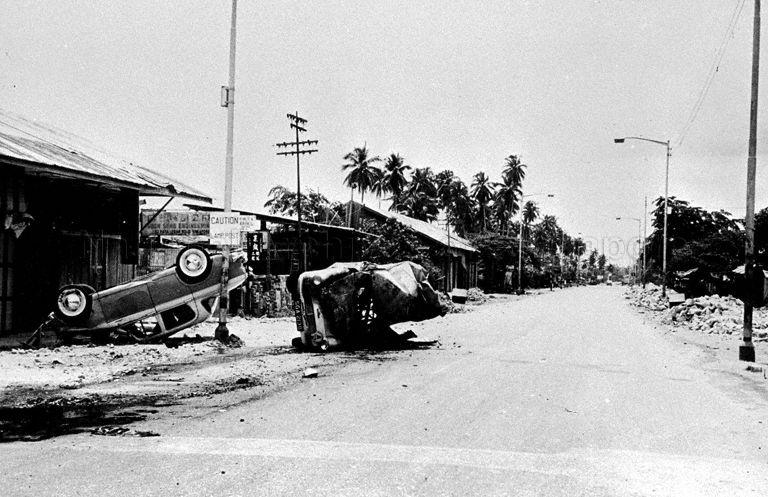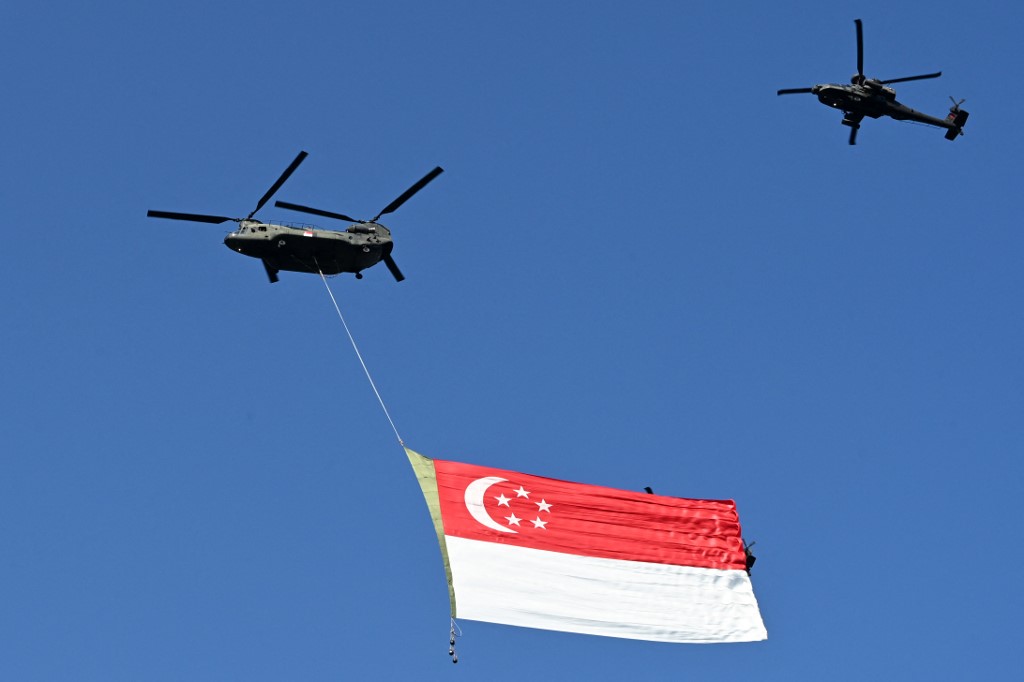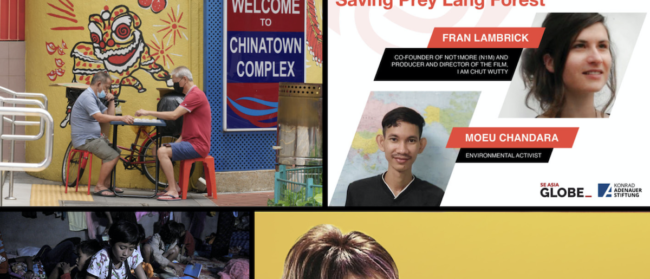On the date celebrated as the Islamic Prophet Muhammad’s birthday, 21 July 1964, Singapore resident Goh Ah San was on his way home when he heard over the car radio that an island-wide curfew would be imposed at 9:30pm.
Suddenly, while driving along Jalan Eunos, a large group of Malay youths appeared. He was forced to stop. One of them then moved towards his car, knocked on the windows, and demanded that he get out. Seeing another car burning on the side of the road, Goh wound down his window and tried his best to negotiate in Malay. Just before he was set to be dragged out, however, Goh spotted police headlights in his rear-view mirror.
He had likely narrowly escaped death at the hands of the mob.
Unfortunately, others were not as lucky as Goh. The 1964 race riots in Singapore, lasting from July 21 until August 7, featured some of the worst civil violence ever to occur in the city-state, with 23 dead and 454 injured. The 1964 riots would mark the beginning of the end for Singapore’s place in the Federation of Malaysia, and just a year after the violence ebbed, they would officially separate on August 9, 1965.
An independent Singapore would go on to experience yet another episode of ethnic riots in 1969. But in contrast to the events of 1964, the 1969 riots were more contained, less lethal and less prolonged. In this instance, rioting only occurred over seven days of fighting, from 31 May to 6 June, in the eastern and northern parts of Singapore, killing four people and injuring 80 more.
This stark difference in levels of ethnic violence, given that the events occurred merely five years apart, presents an interesting puzzle. In examining the events leading up to both riots, two factors emerge in explaining the difference in intensity of conflict between 1964 and 1969 – ethnic agitation by political entrepreneurs in pre-independence Singapore, and the closer interethnic ties on the ground cultivated post-independence.

Ethnic Conflicts in 1960s Singapore
Singapore’s short-lived membership in the Federation of Malaysia began with much promise. As Prime Minister Tunku Abdul Rahman proclaimed in 1963: “In a warm spirit of joy and hope, 10 million people of many races in all the States of Malaya, Singapore, Sarawak and Sabah now join hands in freedom and unity.”
By 1964, however, the “warm spirit” between diverse peoples had been replaced by something else entirely – an outbreak of rioting between Malay and Chinese communities. The sectarian violence shook the young state to its core.
The seeds of the riots had been sown a year earlier after United Malays National Organisation (UMNO), the main Peninsular Malaysian ethnic Malay party, was routed by the Singaporean multiethnic People’s Action Party (PAP) during the 1963 Singapore Legislative Assembly elections. Smarting from the defeat, UMNO began resorting to more extreme strategies to create a support base, firing up Singaporean-Malays by appealing to their ethnicity, religion and the lower economic status as a marginalised community on the island.
For instance, Othman Wok, a PAP minister from the Malay community, recounted that in early July 1964, then-UMNO Secretary-General Syed Jaffar Albar accused Malay PAP members of being “un-Islamic, anti-Islam, anti-Malay and traitors to their own community” at a mass rally. He further declared that “Malays in Singapore have long been oppressed”, and urged that “Malays must unite to defend their own interest”.
Other UMNO extremists, or “ultras”, shared the same sentiments. Mahathir Mohamad, for example, who started his political career in the 1950s and later served as UMNO president, wrote in his memoirs that the “Chinese in Singapore, being mostly wealthy, were not used to the ways of the Malays. They knew them only as servants and members of the poor labouring class of Singapore. By looking down on the Malays, they may have also underestimated the community’s strength.”
When Singaporean Prime Minister Lee Kuan Yew decided to meet with Malay organisations to address Jaffar’s accusations, Jaffar and other UMNO agitators organised a mass protest rally of about 12,000 and created an “Action Committee” to push for special Malay rights and privileges. This committee then circulated a pamphlet a day before the July riots, spreading rumours about an imminent Chinese plot to kill Malays and urging a pre-emptive attack on the Chinese and to destroy the PAP government.
This rising sentiment reached its deadly conclusion at the July celebrations for the Prophet Muhammad’s birthday, held at the Padang. Here, UMNO leaders made emotional speeches mobilising Malays against non-Malays. UMNO’s religious officer, Syed Ali Redza, called upon Singaporean Malays to “unite and arise” to “fight for their rights”.
Emotions only ran higher during the subsequent street procession – historian Albert Lau writes that marchers became increasingly rowdy, shouting and yelling. Rioting then began when marchers attacked a Chinese constable trying to control the crowd. Rumours spread that the policeman first attacked the marchers, and marchers reacted by attacking any Chinese passersby or business establishments within sight. The riots spread to other parts of Singapore as the Chinese retaliated by attacking Malays in predominantly Chinese areas. Residents of Singapore were stunned.
“My cousin sped by in his Triumph motorbike with a sidecar, shouting haltingly that troubles had erupted in Geylang. Some houses were burning and some people were killed and injured,” recounted Chai Chee resident, Yeo Hong Eng. “All of us took that piece of news with expressions of horror and shock. Silence fell with our mouths agape. Our hair stood on ends. Nervousness overtook us.”
I observed the friendly way the people having breakfast treated one another – and how different races commingled with one another … other than the affected areas, the rest of Singapore appeared to be normal and assured
The impact of the riots was profound, and caused a step backwards for ethnic relations in Singapore. As Prime Minister Lee Kuan Yew reflected in his memoirs: “It was impossible to dispel or overcome the deep-seated distrust evoked once irrational killing had been prompted simply by the mere appearance, whether Malay or Chinese, of the victim.”
The fallout from the riots also had the effect of deepening the distrust between the federal and Singaporean governments, culminating in separation in 1965. This separation would ultimately prove pivotal in the far more contained scenes seen five years later during the 1969 riots.
In contrast to 1964, when UMNO politicians raised tensions through political speeches and rumour-mongering, the 1969 riots were precipitated by false rumours spreading from the ground-up as a spill-over effect from the May 13 ethnic riots in Malaysia just a few weeks earlier.
These clashes had occurred soon after the 1969 General Elections, when Malaysians who came to Singapore recounted the dramatic events up north to their Singaporean relatives. Furthermore, according to former member of parliament Joseph Conceicao, rioting resulted from crude gang activity, and violence only broke out when Malaysian Chinese triad leaders, in consultation with top local triad leaders, targeted Malay residents in villages in Seletar and Ubi on May 31.
Malay gangs led the reprisals in the following days, with the Black Hawk Malay Secret Society torching a Chinese-owned sundry shop in Geylang on June 1. The riots ended a week later on June 6 with a total of four dead and 80 wounded, as normalcy would return to Singapore far sooner and with a significantly lower human cost than in 1964.
The question remains, why did one erupt into more than two weeks of intense violence, while the other remained relatively contained and less lethal?

The seriousness of the 1964 riots can certainly be traced to the involvement of political entrepreneurs, who orchestrated the events leading up to the riot to “manufacture” the clash itself. The incentives to do so may be traced to the local political environment at the time, which posed no constraints on UMNO’s mobilisation tactics in Singapore.
In Peninsula Malaysia, UMNO would refrain from making extreme stands against the Chinese to avoid alienating their governing partners in the alliance party, the Malaysian Chinese Association, whose support they needed in majority-Chinese constituencies to retain power. However, UMNO was not constrained by any such power-sharing arrangement in Singapore – on the contrary, UMNO-PAP relations were fraught given the latter’s continued agitation for a “Malaysian Malaysia”, which was perceived as favouring non-Malay ethnicities.
Thus, UMNO had greater incentive to use more extreme strategies to mobilise a Malay support base in Singapore, especially after their humiliation in the 1963 Singapore elections where the PAP trounced UMNO candidates in predominantly Malay constituencies.
In contrast, by 1969, Peninsula-based ethnic parties like UMNO could no longer operate in Singapore after independence after the Singapore government banned local parties with foreign affiliation. The multi-ethnic PAP thus enjoyed dominance of Singapore politics. To maintain their cross-ethnic appeal, the PAP needed to promote interethnic state and grassroots institutions, having the additional effect of preventing ethnic violence.
For example, PAP members of parliament took great steps to calm affected constituents during the 1969 riots. Othman recounted that he personally went around to pacify Malay villagers and reassure them that “the Government will not allow things to become worse”. This was the opposite of UMNO politicians’ actions in 1964 to aggravate the crowd’s feelings. Without a political platform to mobilise based on ethnicity, rioting in 1969 was more contained and less lethal.
In fact, it is noteworthy that secret societies, rather than ethnic nationalist politicians, were the main instigators of violence in 1969. With ethnic violence perpetrated by triad gangs, it thus took on criminal, not political, significance. This made the situation much more manageable for the authorities, who were able to restore calm by preemptively sweeping affected areas for suspected gang members.
Lastly, not only did the lack of an interethnic power-sharing arrangement in 1964 create incentives for political actors to mobilise according to ethnicity, but Othman argues that one of the causes of the 1964 riots was the lack of understanding between ethnic groups because they lived in separate areas. Post independence, by 1969, the Singapore government had begun to address this with a Housing and Development Board (HDB) rehousing scheme which allocated Singaporeans of different ethnicities side-by-side together in public flats, hence allowing them to develop understanding and respect of each other’s culture.
Such increased intercommunal ties disincentivised ethnic violence. Unlike in 1964, when rioting spread viciously across Singapore, the 1969 riots were marked by their geographic containment in specific localities.
For instance, in Katong, which was a hotspot for rioting in 1964, Conceicao noted in 1969: “I observed the friendly way the people having breakfast treated one another – and how different races commingled with one another … other than the affected areas, the rest of Singapore appeared to be normal and assured”.

This week, on August 9, Singapore marks 56 years of sovereignty. While celebrations will be muted due to the pandemic, in normal times the occasion would traditionally be met with the National Day Parade involving fireworks, flypasts and an intricate show segment with thematic performances made to showcase Singapore’s multicultural identity. The “friendly way” that Singaporeans from all walks of life have treated each other is typically celebrated with dances and songs of different ethnic origin.
However, the events of the 1960s are a warning that interethnic harmony did not come about by chance, nor is it guaranteed to always be sustained in the future. In fact, it is today under new pressure in Singapore given the ways in which social media have fuelled identity politics, a trend observed in developed democracies worldwide.
Just two months ago, after an incident where a Chinese man blatantly made racist remarks against an interracial couple along Orchard Road, Law and Home Affairs Minister K Shanmugam commented: “I used to believe that Singapore was moving in the right direction on racial tolerance and harmony. Based on recent events, I am not so sure anymore.”
In the face of such realities, Singaporeans of all backgrounds need to be intentional in their efforts to engage with people of other ethnic groups, both in the physical as well as the online space. Should political entrepreneurs in the future attempt to once again weaponise ethnicity for their own gain, Singaporeans need to be better prepared than they were in 1964.
Joshua Wan is an MPA student at Columbia University, specialising in economic and political development. He completed his Bachelor of Social Science degree in the National University of Singapore with a double major in Social Work and Political Science.


